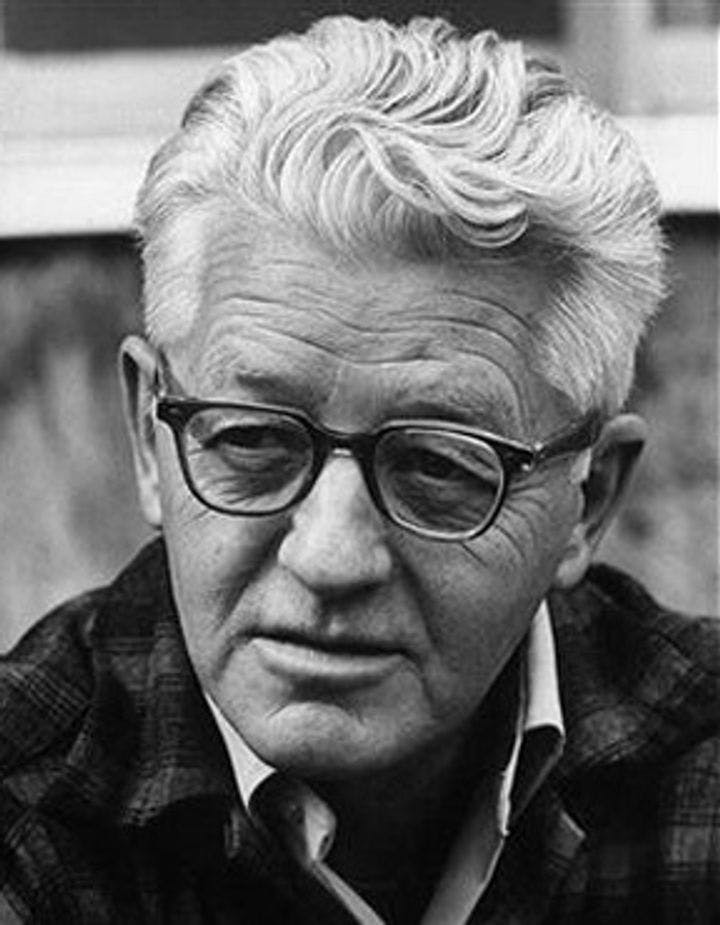Summer 2008
Landscape Artist
– A. J. Loftin
A. J. Loftin on Wallace Stegner, whose fiction is "as wide open as a western sky."
We depend upon our famous writers to drink too much, marry too often, backstab their rivals, and sleep with their students. Wallace Stegner (1909–93), despite a long life at the center of things, never did any of that. He taught conscientiously, published abundantly, and sustained a monogamous marriage for 59 years. The only familiar note is his gradual disillusionment. As the American West that had forged his character and reputation vanished, Stegner found himself literally alone on a hill, surrounded by the garish manses of Silicon Valley. In the end he became attached to Vermont, where, as he observed, nature heals faster.
Stegner once said that Americans were “expected to make the whole pilgrimage of civilization in a single lifetime,” which was “a hell of a thing to ask of anybody.” His own trip started with an impoverished childhood in Iowa and points west and finished with more literary prizes and accomplishments than anyone could want. He started Stanford’s creative writing program in 1946 and ran it for decades; among the students influenced by his exhortation to “write what you know” were Wendell Berry, Edward Abbey, Ken Kesey (whose flippant philosophy—“write what you don’t know”—enraged Stegner), and Larry McMurtry. He served on the board of of the Sierra Club and helped to shape the Kennedy and Johnson administrations’ environmental policies.
Best known for his Pulitzer-winning novel Angle of Repose (1971), a multi-generational saga based on the life of writer and illustrator Mary Foote, Stegner wrote 12 other works of fiction and nine books of nonfiction. Among his most autobiographical novels were The Big Rock Candy Mountain (1943), drawn from his childhood, and Crossing to Safety (1987), a close study of the friendship between two married couples. Stegner also wrote a biography of conservationist John Wesley Powell and other works about the West. But Stegner didn't like being labeled a “western writer,” and with good reason: While attentive to the landscape, his novels were also psychologically probing, nuanced, and painfully honest.
Two previous academic biographies treated Stegner’s literary contributions. Philip Fradkin, an environmental writer based in northern California, aims instead to look at “the whole man—or as close as I can get to him—set against the passing backdrops of his life.” In an epilogue, he describes visits to Stegner’s childhood homes. Not much had stayed the same—which, of course, is Fradkin’s point. To be western is to relinquish everything that was once familiar.
“I was born on wheels,” Stegner wrote of his itinerant frontier childhood. His mother and his only sibling died young; his father, a bootlegger and gambler, killed himself after shooting a girlfriend. Reacting to the instability of his early years, Stegner drove himself to succeed. After graduating from the University of Utah in 1930, he got a master’s and a doctorate at the University of Iowa. There, he met his wife, Mary, by all accounts an extreme hypochondriac, who nonetheless supported her husband’s ambitions “in the manner of a traditional politician’s wife . . . as buffer, filter, cook, hostess, and social secretary.” The Stegners’ only child, son Page, has said it was tough to find his own space in that equation.
Stegner never allowed teaching at Stanford to consume his whole life. He and his wife built a house in Los Altos Hills in 1949, amid pig farms and orchards. There he wrote for several hours each day. Over the next four decades, Stegner witnessed the population explosion that eventually drew him into the national conservation debate. In 1960, in an impassioned and widely circulated the geography of hope” became the environmental movement’s war cry, the West became, Fradkin says, Stegner’s geography of despair. Stegner’s greatest failing, in Fradkin’s view, was his inability to deal with the rapid change that is a constant of western life.
Fradkin’s environmentalist background makes him the right person to re-create Stegner’s physical landscape, and to understand Stegner’s contributions as a conservationist. He’s not always able to penetrate Stegner’s emotional landscape. Fortunately, for that readers can turn to Stegner’s fiction, where the writer laid bare his soul, as wide open as a western sky.
* * *
A. J. Loftin is a writer and editor living in Connecticut.
Reviewed: "Wallace Stegner and the American West" by Philip L. Fradkin, Knopf, 2008.
Photo courtesy of Wikimedia Commons
